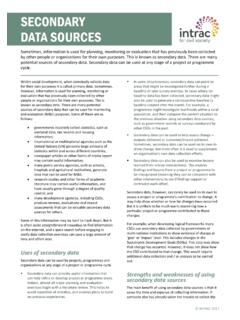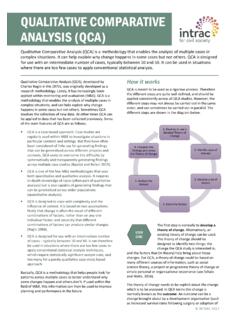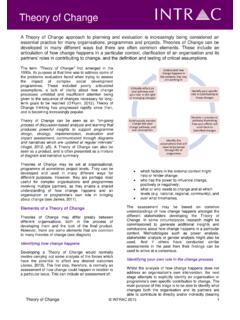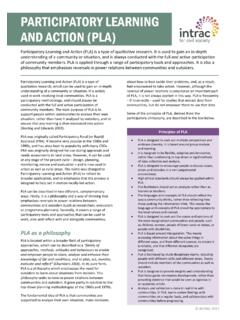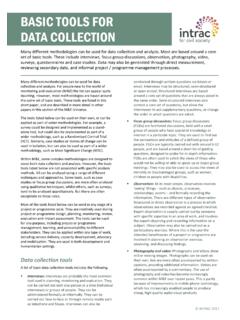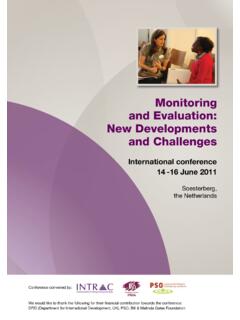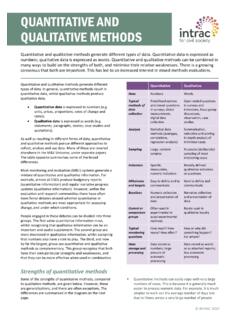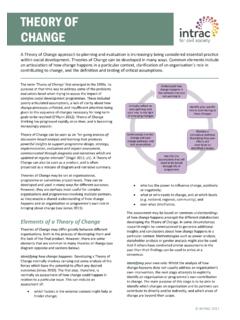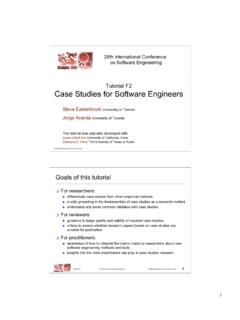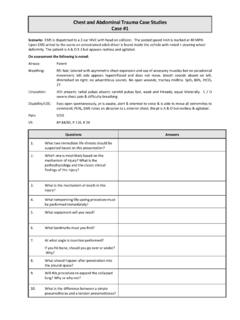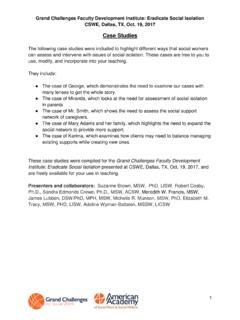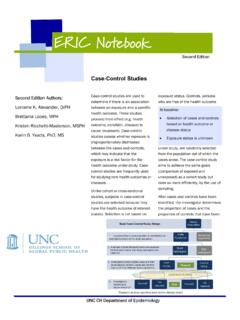Transcription of CASE STUDIES AND STORIES OF CHANGE - INTRAC
1 INTRAC 2017 case STUDIES AND STORIES OF CHANGE case STUDIES or STORIES of CHANGE are often used as alternatives or supplements to quantitative reporting. They may be generated for many different purposes. When used for monitoring and evaluation it is important to ensure that they are generated and used properly. case STUDIES or STORIES of CHANGE can be used on their own, but can also be used as part of a wider methodology. Some changes brought about through social development are straightforward to understand and measure, and it is often possible to use quantitative indicators to capture CHANGE . However, some kinds of CHANGE may be too complex to measure directly. In these situations case STUDIES or STORIES of CHANGE are often used as alternatives or supplements to quantitative reporting. They are believed to be more capable of describing the richness and complexity of individual, organisational or societal CHANGE (CDRA 2001).
2 A case study is a descriptive piece of work that aims to provide in-depth information on a development intervention. It is often based on information acquired through one or more of the tools described in this section of the M&E Universe, such as interviews or observation. A case study can be developed before, during or after a project or programme. case STUDIES often focus on people ( individuals, households, communities). But they can also focus on any other unit of analysis such as locations, organisations, policies or the environment. The possibilities are endless. case STUDIES are usually written, but can also be presented as photographs, drawings or videos. In some circumstances case STUDIES have been presented as songs or dramas. There is no fixed size for a written case study. A case study can vary in length between a few lines of text and an entire book.
3 STORIES of CHANGE are similar to case STUDIES . However, they are always focused on CHANGE . STORIES of CHANGE usually attempt to show how a project or programme has contributed to CHANGE within the lives of its targeted beneficiaries, or to other forms of CHANGE such as policy or organisational CHANGE . This means a story of CHANGE is not normally developed until after a project or programme has started, whereas a case study may be developed at any point. Testimonials are another type of narrative. A testimonial is a written or recorded narrative of an individual s experience of a situation. Testimonials are different from case STUDIES or STORIES or CHANGE . They are an attempt to see a situation purely from the point of view of the person providing the testimonial. However, the terms case study , story of CHANGE and testimonial are not always used consistently within social development.
4 case STUDIES and STORIES of CHANGE within M&E case STUDIES or STORIES of CHANGE may be generated for many different purposes. case STUDIES can be used before a project or programme begins as part of a situational analysis, or as part of a project or programme design process. case STUDIES or STORIES of CHANGE may be used during a project or programme for marketing, publicity or fundraising purposes. They may be used to communicate specific concepts or ideas to different stakeholders. And they may be used to make reports to donors or governments more readable to show the human face behind statistics and broad statements. All of these are valid reasons for developing a case study or story of CHANGE . However, when used within monitoring and evaluation (M&E) there is a need to ensure rigour both in how the case study or story of CHANGE is generated and how it is used.
5 Many different tools and methodologies can be used to generate a case study or story of CHANGE . Ideally, more than one method should be used, and any information produced should then be cross-checked and compared in order to help generate an accurate case study or story of CHANGE that reflects the reality of the situation. At the same time, if it is to be useful for M&E purposes, there needs to be rigour in how a case study or story of CHANGE is used. case STUDIES or STORIES of CHANGE may be used in isolation, or they may be used as part of a wider methodology. case STUDIES and STORIES of CHANGE used in isolation Sometimes a case study or story of CHANGE is used in isolation. In this case it is always important to identify the type of case study and communicate this clearly to the audience. There are many ways of categorising case STUDIES used for M&E.
6 These include the following: Best cases are often used to showcase the biggest or most important changes to which a project or programme has contributed. CSOs routinely use best case STUDIES or STORIES of CHANGE in marketing and communications materials. INTRAC 2017 Typical or representative cases can be useful in describing the typical effect that projects or programmes have on people, communities or organisations. For example, if a project helps support a hundred households a detailed representative case study showing changes in one household can be used to communicate the estimated overall CHANGE across all the households. Illustrative cases may be used to illustrate a key point or message. Within M&E, they are often used to provide more in-depth information in support of a particular finding, lesson or conclusion.
7 Comparative cases are used to compare two or more different situations or to compare CHANGE across different households, communities or organisations. They may be used to help explain why CHANGE occurred in one place but not in another, or to explore the implications of different interventions. Learning cases are used to communicate significant learning that can be used to help improve performance in the future, either within the project or programme that generated the case study, or more widely. Multiple case STUDIES and STORIES of CHANGE Although case STUDIES or STORIES of CHANGE may be used on their own, it is also common to develop and present a set of cases, chosen according to particular criteria. In qualitative analysis this is known as purposeful sampling, which means selecting cases that are most useful for answering specific questions.
8 There are many criteria that can be used for purposeful sampling. For example (see Roche (1999), adapted from Patton (1990)). Unusual, extreme, or deviant cases are chosen because they are unusual. They can be useful in understanding cases which seem to break the rules. They may be used to explain why certain people or organisations seem to achieve particularly good or bad results. Homogenous cases can be used to explore a number of cases covering a particular group or sub-group in-depth. Homogenous sampling is often used to examine changes within a group or sub-group separately from changes in a wider population. Criterion sampling is used to investigate a set of cases that meet certain criteria, such as households headed by women, or girls attending secondary education. These cases can then be used to examine a particular issue or question in further depth.
9 One method used to generate multiple case STUDIES in certain situations is called snowballing. As the name implies, snowballing involves starting off with a few cases (or even a single case ) and then selecting others based on initial findings. This method is most useful when there is not enough information available to make a valid selection of cases at the start of a study, or where the selection of cases depends on having a greater understanding of the situation. There are many other criteria that can be used to select case STUDIES or STORIES of CHANGE . These are described further in the M&E Universe paper on sampling. All the different types of case described above are valid, and all have their uses. But the audience for a case study, or set of case STUDIES , needs to understand what they represent.
10 For instance, it is not useful (or honest) to develop a best- case story and then portray it as typical or representative. Nor is it useful to develop a story based on an unusual or deviant case and then attempt to apply any learning generated from the story more widely. Failure to explain what a case study represents, or how it fits in with a wider portfolio of work, is probably the most common mistake made by M&E practitioners. Wider methodologies for case STUDIES and STORIES of CHANGE There is an increasing trend for multiple case STUDIES or STORIES of CHANGE to be analysed and disseminated together to help build up a complex picture of CHANGE (see diagram). There are several different methodologies that can help do this. Some of these are described below. Most Significant CHANGE (MSC) is a participatory M&E technique that involves the development of STORIES of significant CHANGE that have resulted from a project or programme.
